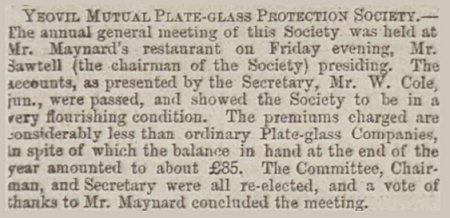Yeovil Mutual Plate-Glass Protection Society
Yeovil Mutual Plate-Glass Protection Society
Yeovil's longest-named Society?
The use of glass as a building material was heralded by The Crystal Palace of 1851, built by Joseph Paxton to house the Great Exhibition. Paxton's revolutionary new building inspired the public use of glass as a material for domestic and horticultural architecture. The requisite technology for the construction of plate-glass had been made possible just a few years earlier by James Hartley, working for the firm Chance Brothers. An early advance in automating glass manufacturing was patented in 1848 by the Engineer Henry Bessemer. His system produced a continuous ribbon of flat glass by forming the ribbon between rollers. This was an expensive process, as the surfaces of the glass needed polishing. Bessemer also introduced an early form of "Float Glass" in 1843, which involved pouring glass onto liquid tin.
Plate-glass became popular for shop fronts during the second half of the nineteenth century as it displayed more of the wares being offered for sale than the earlier, generally smaller windows constructed from several small panes of glass. Plate-glass was, however, very expensive. In order to offset the expense of replacing broken plate-glass windows the unlikely-titled Yeovil Mutual Plate-Glass Protection Society was formed in 1881. It was to last until 1971 as recalled in this article from the Western Gazette's edition of 25 June 1971.
Smashing finale for shop window insurance
A 90-year old Yeovil organisation, formed in the days of the horse-drawn carriage, died this week largely because of the motor-car. The Yeovil Mutual Plate Glass Protection Society, founded in 1881, literally crashed after paying off its last claim.
It was quite a smashing end to the glass insurance business. A car, loaned for display purposes to a local store, reversed through the large plate glass window and the Society's committee decided at an extraordinary meeting on Tuesday that the business was too fragile to cope with modern day conditions. For nearly a century scores of Yeovil tradesmen have enjoyed the Society's success and benefited from many a restored shop window at greatly reduced prices.
After winding up the Society, Secretary Mr BA Collins said the chief reasons were the diminishing number of independent traders in the town and the rapidly increasing costs of glass replacement. As recently as 1956 the non-profit making organisation had over 80 members but since then, with the introduction of nationally controlled supermarkets and the closure of a number of old-established local business houses, membership has taken a sharp plunge.
The Yeovil Mutual Plate Glass Protection Society has been linked with well-known business families throughout its long history. Notable among them are the Sawtell, Snell and Fox families.
In 90 years the Society has kept abreast of the changing times. The first secretary was paid £2.10 a year (around £1,500 at today's value) to keep records of accounts, put in hand immediate repairs to the town's wrecked plate glass and "do all the work of the Society." The man who worked hard for his two guineas a year was Mr Leveritt. But although he was lowly paid it seems the gentleman was not without a sense of humour. Mr Leveritt closed the minutes of the 1881 inaugural meeting with the appropriate glass insurance words "The meeting broke up at 10:15."
Gallery

A report on the Society's 1891 AGM at the restaurant in the Borough owned by William Maynard, from the 6 February 1891 edition of the Western Gazette.